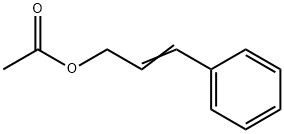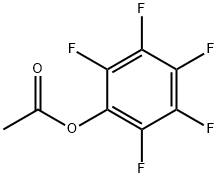Cinnamyl acetate
- CAS NO.:103-54-8
- Empirical Formula: C11H12O2
- Molecular Weight: 176.21
- MDL number: MFCD00008722
- EINECS: 203-121-9
- SAFETY DATA SHEET (SDS)
- Update Date: 2025-01-27 09:38:02

What is Cinnamyl acetate?
Chemical properties
clear colorless to pale yellowish liquid
Chemical properties
Cinnamyl acetate has a characteristic balsamic-floral odor and burning, sweet taste reminiscent of pineapple. The ester obtained from natural cinnamyl alcohol exhibits a more delicate (hyacinth–jasmine-like) note.
Occurrence
Reported found in melon, starfruit, tarragon and litchi.
The Uses of Cinnamyl acetate
Cinnamyl Acetate is used in preparation and characterization of cinnamon essential oil nanocapsules and comparison of volatile components and antibacterial ability of cinnamon essential oil before and after encapsulation.
The Uses of Cinnamyl acetate
Perfumery (fixative), flavoring.
Definition
ChEBI: An acetate ester resulting from the formal condensation of cinnamyl alcohol with acetic acid. Found in cinnamon leaf oil.
Preparation
By direct esterification of cinnamic alcohol with acetic acid (or anhydride) under azeotropic conditions (Arctander, 1969).
What are the applications of Application
Cinnamyl acetate is used as a modifier for Cinnamic alcohol and as a warm-spicy-floral note in heavy florals, Hyacinth, etc. It can also introduce warmth to a Rose composition at a discrete concentration level. Used in flavor compositions for imitation Apple, Apricol, Berry, Cherry, Cinnamon, Cassia, Grape, Peach, Pineapple, Quince, Vanilla, etc.
Taste threshold values
Taste characteristics at 15 ppm: sweet, spicy, floral, cinnamon and honey with a tutti-fruitti nuance.
Synthesis Reference(s)
Journal of the American Chemical Society, 90, p. 5518, 1968 DOI: 10.1021/ja01022a034
General Description
Cinnamyl acetate is a fragrance ingredient. Palladium catalyzed allylic alkylation of cinnamyl acetate using sodium diethyl 2-methylmalonate and novel ferrocenyl Schiff base has been investigated.
Flammability and Explosibility
Non flammable
Safety Profile
Moderately toxic by ingestion and intraperitoneal routes. A skin irritant. Combustible liquid. When heated to decomposition it emits acrid smoke and fumes. See also ALLYL COMPOUNDS.
Properties of Cinnamyl acetate
| Melting point: | 30 °C |
| Boiling point: | 265 °C(lit.) |
| Density | 1.057 g/mL at 25 °C |
| vapor pressure | 16Pa at 20℃ |
| refractive index | n |
| FEMA | 2293 | CINNAMYL ACETATE |
| Flash point: | >230 °F |
| storage temp. | 2-8°C |
| solubility | alcohol: soluble(lit.) |
| form | neat |
| form | Liquid |
| color | Colorless to Light yellow |
| Odor | at 100.00 %. sweet floral spicy balsam cinnamon |
| Water Solubility | 176.2mg/L(temperature not stated) |
| JECFA Number | 650 |
| CAS DataBase Reference | 103-54-8(CAS DataBase Reference) |
| NIST Chemistry Reference | 2-Propen-1-ol, 3-phenyl-, acetate(103-54-8) |
| EPA Substance Registry System | 2-Propen-1-ol, 3-phenyl-, acetate (103-54-8) |
Safety information for Cinnamyl acetate
| Signal word | Warning |
| Pictogram(s) |
 Exclamation Mark Irritant GHS07 |
| GHS Hazard Statements |
H319:Serious eye damage/eye irritation |
| Precautionary Statement Codes |
P305+P351+P338:IF IN EYES: Rinse cautiously with water for several minutes. Remove contact lenses, if present and easy to do. Continuerinsing. |
Computed Descriptors for Cinnamyl acetate
Cinnamyl acetate manufacturer
New Products
1-Amino-1-cyclohexanecarboxylic acid 2-Hydroxyacetamide Ethyl 5-cyclopropyl-1H-pyrazole-3-carboxylate 2,4,6-Trichloroaniline ELECTROLYTIC IRON POWDER 1-Aminocyclobutanecarboxylic acid 1-(2-Ethoxyethyl)-2-(piperidin-4-yl)-1H-benzo[d]imidazole hydrochloride Decanonitrile tert-butyl 4-(1H-benzo[d]iMidazol-2-yl)piperidine-1-carboxylate N,N'-diallyl-1,3-diaminopropanedihydrochloride 3-Iodo-6-nitroindazole (4-(4-Fluorophenoxy)phenyl)methanamine Tert-butyl N-(pent-4-yn-2-yl) carbamate 2-Chloro-3-nitropyridine 5-Bromo-2,3-dimethoxypyridine 2-chloro-4-methyl-5-nitro pyridine 2,5-dibromopyridine terephthalonitrile 5-Bromo-4-chloro-2(1h)-pyridinone, 5-Fluoro-2-Oxindole N, N-Carbonyldiimidazole (CDI) 5-Cyanophthalide 10-Methoxy-5H-dibenz[b,f]azepine 2-AMINO-3,5-DIBROMO BENZALDEHYDE [ADBA]Related products of tetrahydrofuran








You may like
-
 103-54-8 Cinnamyl Acetate 98%View Details
103-54-8 Cinnamyl Acetate 98%View Details
103-54-8 -
 103-54-8 98%View Details
103-54-8 98%View Details
103-54-8 -
 Cinnamyl acetate 98%View Details
Cinnamyl acetate 98%View Details
103-54-8 -
 Cinnamyl acetate 98% CAS 103-54-8View Details
Cinnamyl acetate 98% CAS 103-54-8View Details
103-54-8 -
 Cinnamyl acetate CAS 103-54-8View Details
Cinnamyl acetate CAS 103-54-8View Details
103-54-8 -
 Cinnamyl Acetate CAS 103-54-8View Details
Cinnamyl Acetate CAS 103-54-8View Details
103-54-8 -
 Cinnamyl acetate CAS 103-54-8View Details
Cinnamyl acetate CAS 103-54-8View Details
103-54-8 -
 609-15-4 Ethyl-2-ChloroacetoacetateView Details
609-15-4 Ethyl-2-ChloroacetoacetateView Details
609-15-4